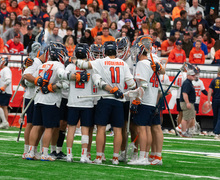Alumnus takes to Ferguson’s streets to cover protests
When Chico Harlan returned to The Washington Post after completing an assignment in Florida, it was just another day. Then an editor spotted him across the newsroom and asked him a question: How did he feel about making a trip to Missouri?
“They handed me some armored gear and a gas mask and off I went to cover this thing in St. Louis,” Harlan said. “It was really surreal.”
Harlan (’04), a reporter on The Washington Post’s economics desk, traveled to Ferguson, Mo., twice to help with the paper’s coverage of the Michael Brown case. He spent five or six days in Ferguson in August and returned in November for an eight-day stretch.
On Aug. 9, Brown was shot and killed by Ferguson Police Officer Darren Wilson. On Nov. 24, a grand jury decided not to charge Wilson with any crimes related to the fatal shooting. The case has since set off waves of protests in Missouri and throughout the country.
Harlan called the assignment “a very interesting way to re-experience America.”
“I had never covered anything like that before,” he said. “I had covered other big stories but nothing that was so contained on the streets.”
Harlan was never in danger during his time in Ferguson, and said when he first arrived in August that many residents seemed happy to have the media there. Its presence gave the residents almost a “sense of vindication” and made them feel protected since they knew police confrontations were less likely with cameras around, he said.
Much of Harlan’s reporting consisted of daily — and sometimes hourly — updates about what was happening in Ferguson. Harlan also had the job of calling Wilson, the police officer, and members of his family.
The challenge with reporting on a national story like Ferguson is finding different angles to cover, Harlan said. One way Harlan did this was with an article he wrote about Delmar Boulevard in St. Louis. Delmar runs east to west and divides the city racially, with black people in the northern areas and white people in the southern areas, Harlan said.
“You can sort of see just along the two sides of this road how this racial divide actually worked and how the suspicions were so different depending on which side you stood on,” he said.
Outside of his own reporting, Harlan was also able to learn firsthand how The Washington Post covers big national stories. The paper had six or seven reporters in Ferguson in August and four when the grand jury verdict was announced in November.
But the paper didn’t lose track of the story when it faded from the news cycle between August and November, and kept a few reporters on the ground in Ferguson, Harlan said. This really shows the amount of manpower necessary for these types of stories, he added.
For Harlan, all the opportunities he has had in his career come back to his time at The Daily Orange, where he worked in the sports department. Harlan said he’s thankful for all the people he met at The D.O. who taught him so much about journalism.
“I’m always sort of feeling a sense of gratitude towards The D.O., more so really than any other stop along my career,” he said. “That was the key.”
Published on September 10, 2015 at 10:48 am
Contact Jessica: jliannet@syr.edu | @JessicaIannetta




